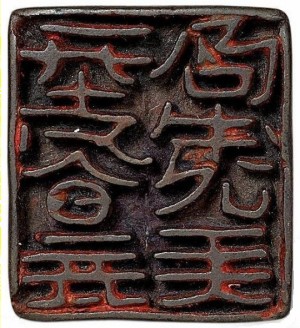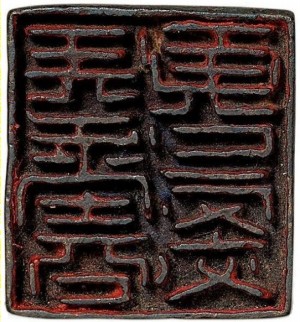BabelStone Blog
Tuesday, 16 October 2012
Khitan Seals
The Liao dynasty (907–1125) was the first Chinese dynasty to be ruled by a non-Chinese people (the Khitans) who used their own writing system to represent their own language (in the case of the Khitans, two separate writing systems). During the Liao dynasty there were two parallel divisions of government, the Northern Administration which conducted its business exclusively in the Khitan language, and the Southern Administration which conducted its business mostly in Chinese. Bronze seals of office were made in both Chinese script and Khitan large script, presumably reflecting the division of government that the office holder belonged to.
This post provides a preliminary survey of seals that have been identified as having a seal face inscription in either the Khitan large script or the Khitan small script. A number of Khitan official seals have been found over the years, but some of them remain unpublished or without good quality published images, so this post is far from complete. Much of the analysis of Khitan inscriptions presented here is tentative, and I hope to expand and improve this post as and when more information comes to light. My reading of Khitan inscriptions given in this post relies heavily on the decipherments made by many Khitan scholars, in particular Liú Fèngzhù 劉鳳翥, but I am of course responsible for any errors or misunderstandings. I am also indebted to Viacheslav Zaytsev of the Institute of Oriental Manuscripts for helping me locate resources, and providing many helpful suggestions.
Liao dynasty official seals on display at the Liaoning Provincial Museum in Shenyang
{ Seal 1 = A5c | Seal 2 = A6 | Seal 3 = Chinese | Seal 4 = B4 }
A. Ninefold Seal Script Official Seals
During the Song dynasty (960–1279) Chinese characters on official seals were engraved using a highly stylized style of calligraphy known as "ninefold seal script" (九疊篆 jiǔdiézhuàn) that was based on archaic Small Seal Script character forms, but with tightly convoluted strokes. This complex style of calligraphy was applied to both Chinese script and Khitan script official seals during the Liao dynasty. This set a precedent that was followed by the Western Xia, Yuan and Qing dynasties, which developed mock archaic ninefold seal script forms of Tangut, Phags-pa and Manchu respectively, for use on official seals. Of the non-Chinese dynasties, only the Jurchen Jin dynasty that succeeded the Liao seems to have only used Chinese script on seals.
As there is no surviving key to Khitan seal script characters it is often very difficult to determine what standard form Khitan large character a seal script character corresponds to, especially as the meaning of most Khitan large script characters is unknown or uncertain. A table of Khitan ninefold seal script characters is appended at the bottom of this post.
Seal A1
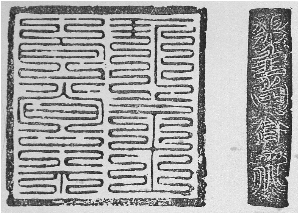
Wenwu 文物 1983.8 p.82.
References : KSRG 1978 plate 38; Xiang Chunsong 1983.
Found at : Chifeng, Inner Mongolia (内蒙古自治區赤峰市翁牛特旗河南营子) in 1965.
Present Location : Chifeng Museum (赤峰市博物館).
Description : Bronze seal. Dimensions: 9.0 × 9.0 cm, with a 4.8 cm handle marked with the Chinese character shàng 上 "up" twice. On the right side of the seal is an inscription comprising the same five Khitan large characters on the seal face, but in standard calligraphy engraved in outline.
Inscription : Five Khitan large characters in ninefold seal script calligraphy (27 folds), in two columns (two characters in the first column and three characters in the second column).
Interpretation
Unusually, the seal face inscription is repeated on the side of the seal in standard form characters, making the inscription easier to read:


The first three characters are thought to correspond to the Chinese office of Shumiyuan 樞密院, translated in English as the Bureau of Military Affairs. The third character can occur on its own as an apparent abbreviation for the Bureau of Military Affairs following either of the two parallel divisions of the Liao government, the Southern Administration and the Northern Administration:
- "Bureau [of Military Affairs] of the Southern Administration" [Epitaph for Yelü Qi (耶律褀墓誌) line 13]
- "Bureau [of Military Affairs] of the Northern Administration" [Epitaph for Yelü Qi (耶律褀墓誌) line 23]
The penultimate character in the seal inscription is the genitive particle *-un. Several different genitive particles are used in the Khitan large script (, , being among the most common), and probably corresponds to the Khitan small script genitive particle  *un which generally occurs after words with a u vowel or ending in w (this rule does not always seem to be adhered to). It is noteworthy that even though Khitan Large Script epitaphs use a variety of different genitive particles in different contexts, only this one particular genitive particle is used on any of the seal inscriptions that I have seen, and it even occurs after characters that take a different genitive particle in epitaphs (see Seal A2). This suggests that seal inscriptions use a fixed genitive particle that does not obey the normal grammatical rules of the Khitan large script.
*un which generally occurs after words with a u vowel or ending in w (this rule does not always seem to be adhered to). It is noteworthy that even though Khitan Large Script epitaphs use a variety of different genitive particles in different contexts, only this one particular genitive particle is used on any of the seal inscriptions that I have seen, and it even occurs after characters that take a different genitive particle in epitaphs (see Seal A2). This suggests that seal inscriptions use a fixed genitive particle that does not obey the normal grammatical rules of the Khitan large script.
The final character in the seal inscription is the the word (normally written in epitaphs) *doro which means both "ceremony, ritual, rite" (Chinese lǐ 禮) and "seal" (Chinese yìn 印). The Khitan word for "ceremony" and "seal" was borrowed into Jurchen, with a very similar glyph ( ), the same two meanings and the same pronunication *doro (Manchu doro ᡩᠣᡵᠣ preserves the meaning "ceremony", although the word temgetu ᡨᡝᠮᡤᡝᡨᡠ is used for "seal").
), the same two meanings and the same pronunication *doro (Manchu doro ᡩᠣᡵᠣ preserves the meaning "ceremony", although the word temgetu ᡨᡝᠮᡤᡝᡨᡠ is used for "seal").
The seal inscription thus means "Seal of the Bureau of Military Affairs" *[?] uru [?]-un doro (樞密院之印).
Seal A2a
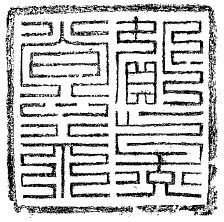
Beifang Wenwu 北方文物 2012.3 p.62.
References : Liu Fengzhu 2012.
Found at : Ma'anshan Bridge, Guang'en Township, Bin County, Heilongjiang (黑龍江省賓縣光恩鄉馬鞍山大橋) in 1994.
Present Location : Bin County Cultural Relics Office (賓縣文物管理所).
Description : Bronze seal. Dimensions: 7.6 × 7.6 cm.
Inscription : Five Khitan large characters in ninefold seal script calligraphy (18 folds), in two columns (three characters in the first column and two characters in the second column). The 2nd and 3rd characters are squeezed into a single character space, with the result that they do not have as many folds as normally expected.
Interpretation
The first character is the Khitan version of the Chinese character dū 都 "metropolitan". Chinese du is usually represented using the Khitan character , but it is sometimes transliterated using the character , borrowed directly from Chinese. This character occurs in the Epitaph for the Grand Prince of the North:
- "Director-in-chief of the south west" (西南都監) [line 13]
Liu Fengzhu has identifed the next character as , which is used to represent the Chinese characters tǒng 統 and tóng 同 on epitaphs:
- "Commander of the army" (統軍) [Epitaph for the Grand Prince of the North line 17]
- "Commander of the army for Fuzhou" (鄜州之統軍) [Epitaph for Yelü Qi line 11]
- "Tongzhou" (同州) [Epitaph for the Grand Prince of the North line 14]
The first two characters together represent the Chinese title dū tǒng 都統 "Commander-in-chief".
The third character (at the bottom of the first column) is the Khitan character *pu, which is commonly used to transliterate Chinese characters pronounced fu, including 府 fǔ "prefecture" or "headquarters", 夫 fú "man", 父 fù "father", 副 fù "vice, deputy", 傅 fù "tutor". In this context it is used to transliterate Chinese fǔ 府 "prefecture" or "headquarters", joining onto the two preceding characters to make "Headquarters of the Commander-in-chief".
The last two characters of the seal inscription are *-un doro "seal of ..." (之印). It is interesting to note that on this and other seal inscriptions the genitive particle is used after the character *pu (cf. Seal A6), whereas in epitaphs *pu is always (in the incomplete corpus of inscriptions I have studied) followed by the genitive particle :
- "of the Northern Prefecture" [Epitaph for Dorlipun lines 13–14]
- "of the Grand Tutor" [Epitaph for Xiao Paolu (蕭袍魯墓誌) line 10]
- "of the Upper? Northern Prefecture" [Epitaph for Xiao Paolu line 11]
- "of the Northern Prefecture" [Epitaph for Yelü Qi line 15]
The seal inscription can be translated as "Seal of the Headquarters of the Commander-in-chief" (Chinese dūtǒngfǔ zhīyìn 都統府之印).
Seal A2b
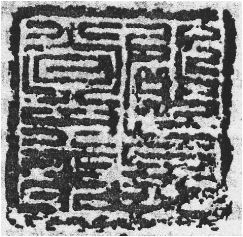
Kaogu 考古 1990.12 p.1143.
References : Li Yufeng 1990; Iguro Shinobu 2005 #25.
Found at : Songjiadian Village, Panshan County, Liaoning (遼寧省盤山縣宋家店村) in 1986.
Present Location : Panshan County Cultural Relics Office (盤山縣文物管理所).
Description : Bronze seal. Dimensions: 7.5 × 7.5 × 1.5 cm, with a 2.5 cm handle marked with the Chinese character shàng 上 "up". Weight: 0.9 kg.
Inscription : Identical to Seal 2A The bottom of the first column is hardly legible, but can be reconstructed by reference to seal 3A.
Seal A3
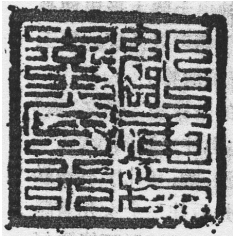
Kaogu 考古 1990.12 p.1143.
References : Li Yufeng 1990.
Found at : Kezuo, Liaoning (遼寧省喀左縣) in 1973.
Present Location : Kezuo Museum (喀左縣博物館).
Description : Bronze seal.
Inscription : Six Khitan large characters in ninefold seal script calligraphy (20 folds), in two columns (three characters in each column).
Interpretation
The 1st character is the same as the first character on Seal 2, and presumably transliterates Chinese dū 都. The following two characters are a little unclear on the seal rubbing, and I have not been able to identify their standard character forms. The 4th character *pu here probably transliterates Chinese fǔ 府 "prefecture" or "headquarters". The final two characters are *-un doro "seal of ..." (之印).
Seal A4a
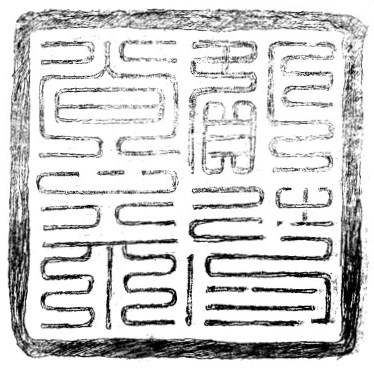
KSRG 1978 plate 48.
References : KSRG 1978 plate 48.
Found at : Unknown (impression of seal owned by Luo Fuyi 羅福頤).
Description : Bronze seal.
Inscription : Four Khitan large characters in ninefold seal script calligraphy (18 folds), in two columns (two characters in each column).
Interpretation
The 1st character is the same as the first character on Seals 2 and 3, and presumably transliterates Chinese dū 都. I have not been able to identify the standard character form of the following character, but it may be a Khitan logograph corresponding to Chinese dū 督, in which case the first two characters of the seal inscription represent the Chinese title dū dū 都督 "Area Commander". The final two characters are *-un doro "seal of ..." (之印).
Seal A4b
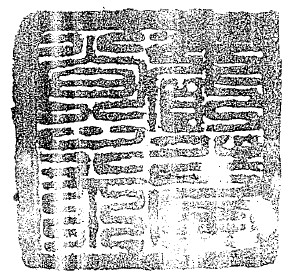
Liaohai Wenwu Xuekan 1989.2: 98.
References : Pei Yaojun 1989.
Found at : Site of the Liao-Jin city of Hanzhou (韩州), southeast of Bamiancheng Township, Changtu County, Liaoning (遼寧省昌圖縣八面城鎮東南古城) in 1983.
Present Location : Unknown.
Description : Bronze seal. Dimensions: 7.8 × 7.8 × 1.9 cm, with a 2.7 cm handle marked with the Chinese character shàng 上 "up". Weight: 1.1 kg.
Inscription : Identical to Seal 4A.
Seal A5a
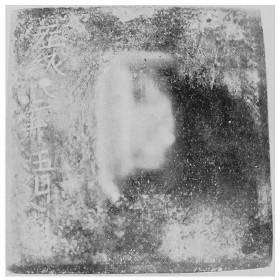

Tōyōshi Kenkyū 東洋史研究 vol.3 no.4 (April 1938) plate 4.
References : Imanishi 1938; KSRG 1978 plate 50.
Found at : Unknown.
Present Location : Unknown (was in the collection of Imanishi Shunjū 今西春秋).
Description : Bronze seal. On the back of the seal, to the left of the handle, is an inscription comprising a single column of eight Khitan large characters, giving the date that the seal was issued as the 22nd year of the Tonghe era [1004] (see below for discussion).
Inscription : Five Khitan large characters in ninefold seal script calligraphy (18 folds), in two columns (three characters in the first column and two characters in the second column).
Interpretation
The first character *pu is commonly used to transliterate Chinese characters pronounced fu (see Seal A2). The second character is read *u, and the two characters together (*fu.u) can be used to transliterate the Chinese word 副 fù "vice, deputy":
- "Vice Marshal" (副元師) [Epitaph for Yelü Qi lines 4 and 6]
The next character is , which is used to represent the Chinese character tǒng 統 on epitaphs. The first two characters together represent the Chinese title fùtǒng 副統 "Vice Commander-in-chief".
The last two characters of the seal inscription are the standard *-un doro "seal of ...".
The complete inscription can be translated as "Seal of the Vice Commander-in-chief" (Chinese fùtǒng zhīyìn 副統之印). A large number of Jin dynasty bronze seals with the Chinese inscription fùtǒng zhīyìn 副統之印 are known (e.g. Zeno #56522), but as the title fùtǒng 副統 was used during the Liao dynasty as well as during the Jin dynasty (see Liao Shi chapters 16, 17, 25 and 115, where in each case military campaigns are led by a Dutong 都統 "Commander-in-chief", a Futong 副統 "Vice Commander-in-chief", and a Dujian 都監 "Army Supervisor") it is possible that some of the Chinese fùtǒng zhīyìn 副統之印 seals identified as dating to the Jin dynasty may actually date to the Liao dynasty. In the case of this seal, we can be sure that it dates to the Liao dynasty rather than the Jin dynasty as the date of issue of the seal is inscribed on the back of the seal:
- "A day in the 5th month of the 22nd year of the Tonghe era [1004]" (統和廿二年五月 日)
The second character is a variant of , and the 1st and 2nd character together () have been identified by Yan Wanzhang 閻萬章 as the Khitan name for the Tonghe 統和 era (983–1012) of the Liao dynasty (see Wang Yunlong 王雲龍, 《契丹大字〈耶律昌允墓誌〉考釋》2001 p.54). My thanks to Dr. Takeuchi Yasunori (武内 康則) of Otani University for pointing this identification out to me. The Tonghe era is mentioned in the Epitaph for Yelü Changyun (耶律昌允):
- "The white sheep day of the blue dog month of the white rat year, the 18th [year] of the Tonghe era" (統和十八庚子年甲戌月辛未日) [Epitaph for Yelü Changyun line 10]
In addition to this Khitan name for the Tonghe era, in the Epitaph for the Grand Prince of the North the Tonghe era is written as "heaven" plus two completely different characters :
- "At 39 years of age in the 29th year of the Tonghe era" (歲三十九於統和二十九年於) [Epitaph for the Grand Prince of the North line 11]
In both the Epitaph for Yelü Changyun and the Epitaph for the Grand Prince of the North context indicates that the reading of the words and respectively as Tonghe is correct. The difference between the two forms of the Khitan name for the Tonghe era seems to be that represents the era name logographically, whereas represents the era name phonographically. This can be seen from the use of to represent the second syllable of the Chinese title dū tǒng 都統 "Commander-in-chief" in the Epitaphs for the Grand Prince of the North and Yelü Qi:
- "Commander-in-chief of the capital commands the army" (京之都統統軍) [Epitaph for the Grand Prince of the North line 17]
- "Commander-in-chief of the empire" (天下都統) [Epitaph for Yelü Qi line 6]
In seal inscriptions (e.g. Seal 2), dū tǒng 都統 is represented logographically as . Thus it seems that words such as Tonghe and dū tǒng can be represented either logographically or phonographically according to the whims of the author, and can even be written both logographically and phonographically in the same sentence by the same author, as seen in the example from the Epitaph for the Grand Prince of the North line 17 shown above. This lack of a fixed orthography for writing the Khitan large script only adds to the difficulties of deciphering Khitan large script inscriptions.
Seal A5b

Beifang Wenwu 北方文物 1986.2 p.49.
References : Yin Yushan 1986.
Found at : Yongji County, Jilin (吉林省永吉縣黃榆鄉) in 1984.
Present Location : Unknown.
Description : Bronze seal. Dimensions: 7.8 × 7.8 × 1.7 cm, with a 3.0 cm handle marked with the Chinese character shàng 上 "up".
Inscription : Identical to Seal 5A.
Seal A5c
References :
Found at : Unknown.
Present Location : Liaoning Provincial Museum, Shenyang (遼寧省博物館).
Description : Bronze seal.
Inscription : Identical to Seal 5A.
Seal A6
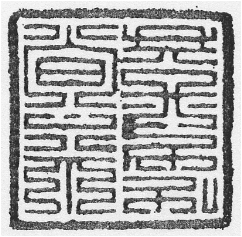
Wen Wu 文物 1984.09 p.83.
References :
Found at : Fengcheng, Liaoning (遼寧省鳳城縣) in 1964.
Present Location : Liaoning Provincial Museum, Shenyang
Description : Bronze seal with a handle.
Inscription : Six Khitan large characters in ninefold seal script calligraphy (18 folds), in two columns (three character per column).
Interpretation
The seal inscription comprises six Khitan large characters in two columns, four characters in the first (righthand) column, and two in the second (lefthand) column.
The second character elsewhere only occurs as the first element in the collocation , of uncertain reading and meaning, that may be an unknown Khitan word for Liao or an epithet specifically refering to the Khitan state (see Kane 2009 pp.162–165 for discussion of the corresponding term in the Khitan Small script). The word occurs in monumental inscriptions as well as in the recently identified Khitan codex (see Viacheslav P. Zaytsev, Рукописная книга большого киданьского письма из коллекции Института восточных рукописей РАН [A Manuscript Codex in the Khitan Large Script from the Collection of the Institute of Oriental Manuscripts, Russian Academy of Sciences] (2011) pp. 143–146).
- "[...]" [Epitaph for the Grand Prince of the North line 19]
- "Great [...] State" (大□□國) [Epitaph for Yelü Qi line 1]
- "Great Central [...] Khitan State" (大中央□□契丹國) [Nova N 176]
The character following is definitely not . However, the preceding character (i.e. the first character of the seal inscription) could conceivably be a seal script form of , but that would give a reversed form of the unknown word, which seems a little implausible. I am unsure of what standard Khitan characters the two characters which actually follow correspond to.
The last two characters of the seal inscription are *-un doro "seal of ...", as expected.
Seal A7


Wenshi 文史 2003.1 p.178.
References : Liu Fengzhu 2003.
Found at : Unknown.
Present Location : Unknown (a photograph of an impression of the seal was sent to Liu Fengzhu for identification by Luo Suizu 羅隨祖 of the Palace Museum, Beijing).
Description : Bronze seal with a handle. On the back of the seal is a Chinese inscription zuǒ dūjiàn 左都監 "Director-in-chief of the left" to the right of the handle, and the Chinese character shàng 上 "up" above the handle.
Inscription : Nine Khitan large characters in ninefold seal script calligraphy(22–25 folds), in three columns (three character per column). The calligraphy is not as controlled as other ninefold seal inscriptions: the total number of folds varies across columns, the folds do not always align across columns, and there some diagonal strokes.
Interpretation
Liu Fengzhu has read the inscription on this seal as □□, being a transliteration of the Chinese yuánshuài zuǒdūjiàn yìn 元帥左都監印 "Seal of the Marshal's Director-in-chief of the Left". This title did not exist during the Liao dynasty, but was in use during the Jin dynasty, and Liu Fengzhu notes that several Jin dynasty bronze seals inscribed in Chinese 元帥左都監印 "Seal of the Marshal's Director-in-chief of the Left" or 元帥都監之印 "Seal of the Marshal's Director-in-chief" are known, indicating that this must be a Jin dynasty seal, presumably made sometime before 1191 when the use of the Khitan script was proscribed by the Jin government. Liu Fengzhu's interpretation of the inscription is undoubtedly correct.
The first five Khitan characters transliterate the Chinese title "marshal", written phonographically with the three characters representing the phonemes /ŋ/, /üe/ and /an/ (for Chinese 元 *ŋĭwan) and the two characters representing the phonemes /ʃ/ and /oi/ (for Chinese 帥 *ʃoi). The word "marshal" occurs five times in the Epitaph for Yelü Qi, with four out of the five characters matching the seal inscription, and only the third phonogram written as a different character:
- "Marshal" (元師) [Epitaph for Yelü Qi lines 4 and 6]
- "Marshal" (元師) [Epitaph for Yelü Qi lines 7 and 8]
Based on the Chinese inscription on the back of the seal, the next three characters should transliterate the Chinese title for "Director-in-chief of the Left", and the third character () does indeed match the Khitan character corresponding to Chinese jiàn 監 in epitaphs:
- "Director-in-chief of the South-west" (西南都監) [Epitaph for the Grand Prince of the North line 13]
- "Director-in-chief" (都監) [Epitaph for Yelü Qi line 10]
- "Director-in-chief" (都監) [Epitaph for Xiao Pao line 7]
Liu Fengzhu does not identify the standard form of the Khitan character preceding on the seal (top character of the right column), but it seems to be , corresponding to Chinese dū 都 in the two inscriptions shown above. Neither does Liu Fengzhu identify the standard form of the Khitan character in front of that (bottom character of middle column), but it should be a form of meaning "left".
Seal A8
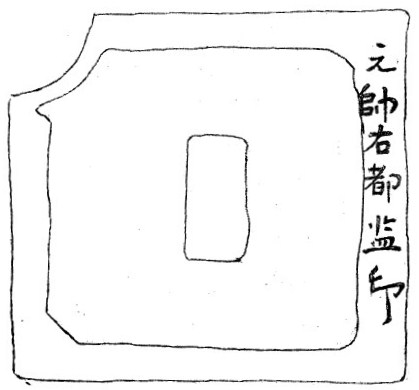

KSRG 1978 plate 51.
References : KSRG 1978 plate 51.
Found at : Weichang Manchu and Mongol Autonomous County, Hebei (河北圍場縣).
Present Location : Unknown (was in the possession of Shi Shuqing 史樹青).
Description : Bronze seal. On the back, along the right edge is an inscription in Chinese characters: 元帥右都監印 "Seal of the Marshal's Director-in-chief of the Right".
Inscription : Eight Khitan large characters in loose, rather idiosyncratic ninefold seal script calligraphy (22–24 folds), in three columns (three character in the 1st column, two characters in the 2nd column, and three characters in the 3rd column).
Interpretation
As with Seal 7, the seal holder's office is inscribed on the back of the seal (元帥右都監印 "Seal of the Marshal's Director-in-chief of the Right"), which helps us interpret the inscription on the seal face. This title is very similar to that on Seal 7, and is not a title used during the Liao dynasty, so must also date to the Jin dynasty. As with other Jin dynasty Khitan seals, the ninefold seal script calligraphy is not as tight and uniform as the calligraphy on Liao dynasty seals.
The first two characters are the same as the 2nd and 3rd characters on Seal 7, that is the medial and final phonemes /üe/ and /an/ corresponding to Chinese 元 *ŋĭwan. Unexpectedly, the nasal onset is omitted, maybe because ŋ- has been lost in the dialect of the writer of the inscription. I cannot identify the standard form of the 3rd character, but from context it must be correspond to Chinese shuài 帥 "commander". In Seal 7 and in epitaph inscriptions, shuài 帥 is represented phonographically as (/ʃ/ + /oi/), but on this seal the term is written with a single character, which must be a logograph. The 4th and the 5th characters are the same as the 7th and 8th characters in Seal 7, transliterating Chinese dū jiàn 都監 "Director-in-chief". On the back of the seal, the seal holder's office is given as "Director-in-chief of the Right", but "right" is omitted from the seal face inscription. The 6th character is partially missing due to physical damage to the corner of the seal, so is difficult to identify. The only plausible character in this position would be *pu for Chinese fǔ 府 "headquarters", but the seal character is definitely not the same. The 7th and 8th characters are the standard *-un doro "seal of ...", although the genitive particle is written with a 目 component instead of the expected 日 component.
Seal A9

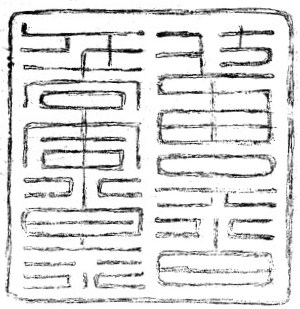
KSRG 1978 plate 42.
References : KSRG 1978 plate 42.
Found at : Ili Kazakh Autonomous Prefecture, Xinjiang (新疆自治區伊犁州).
Present Location : National Museum of China, Beijing.
Description : Bronze seal with a handle marked with the Chinese character shàng 上 "up". On the back of the seal is a Khitan large script inscription in 22 characters, written around the four edges of the seal. The first twelve characters give the date and location that the seal was issued, and the last ten characters are the same as the inscription on the seal face.
Inscription : Ten Khitan large characters in ninefold seal script calligraphy (17–19 folds), in two columns (five characters in each column).
Interpretation
The seal face inscription is identical to the last ten characters of the inscription on the back of the seal. Starting at the top right corner, and reading clockwise around the four edges, the inscription reads:
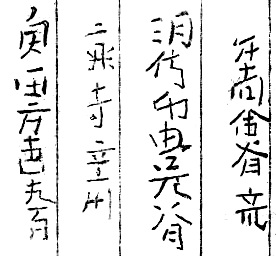 |
|
The first character is normally written , and the first two characters together form the Khitan word meaning "good fortune" (Chinese fú 福), reconstructed as *qudug. The word occurs commonly as a personal name or as part of a personal name:
- "General Qudug of the Northern Headquarters" (北府之福將軍) [Epitaph for Dorlipun lines 13-14]
- "Councilor Hudujin" (于越胡獨堇) [Epitaph for Yelü Qi line 16]
The third character does not occur in epitaph inscriptions (at least not in the form used in this inscription). It may simply be the character meaning "ten thousand", with an extraneous first stroke. The next three characters all occur in Khitan epitaphs, but their meanings are unknown. The 5th character is probably to be read with a dot as . The collocations and occur on the Epitaph for Xiao Paolu lines 4 and 1 respectively, but I have not seen any examples of the three characters together. The 7th character means "two", the 8th character mean "year", and the 9th character is a dative particle, so these three character together mean "in the 2nd year of". This implies that the characters before "2nd year" are an era name. Aisin-Gioro Ulhicun (《韓半島から眺めた契丹・女真》 2011, p.10) has identified the Khitan name for the Yingli 應曆 era (951-969) as "Heaven good fortune" (Chinese 天福), in which case the first two characters on this inscription may refers to the Yingli 應曆 era, although the omission of the "heaven" prefix would be very unusual. However, as discussed below under Seal A14, I believe that the six characters represent the Khitan form of the Western Liao Chóngfú 崇福 ("Venerating good fortune") era (1164–1178) which was used by the Empress Dowager Chengtian 承天太后, so I believe that the date on this seal actually corresponds to the 2nd year of the Chóngfú era, i.e. 1165.
The 10th character is uncommon in epitaph inscriptions, but a possible variant form occurs on a fragment of a Khitan manuscript, where it is glossed in Old Uyghur script as ši-. The 11th character is a common character in epitaph inscriptions, where it represents the phoneme *li in words such as *Dorlipun (personal name) and *olibun "preface" or "first day of the lunar month". On the other hand, it is possible that this character is actually intended to be the graphically similar (and also very common) character , which means "son". Either way, it is not obvious what the two characters mean in this context.
The 12th character looks as if it might be the two characters "third month" written side-by-side in the space for a single character, presumably indicating the month in which the seal was issued. However, it is separated from the "2nd year" part of the inscription (the dative particle should be placed at the end of the full date), so it should not be part of the date. This character also occurs in the inscription on Seal A14 (also at the end of the first part of the inscription, before the copy of the seal face inscription), where it cannot plausibly mean "third month" because "third month" is already given earlier in the inscription.
The 13th through the 22nd characters are a copy of the seal face inscription, but aside from the genitive particle at the end of the third edge (17th character) and the standard formula "seal of" at the end of the fourth edge, the meaning of the inscription is unclear. I think that the 18th character is a badly written form of the character meaning "left" (as in left and right divisions of official positions). The 19th and 20th characters in the collocation twice in the Epitaph for Yelü Qi (lines 20 and 22), which has been suggested is the phonographic spelling dia-an gia-an for Chinese diǎnjiǎn 點檢 "inspectorate", in which case would represent dia-an.
Seal A10
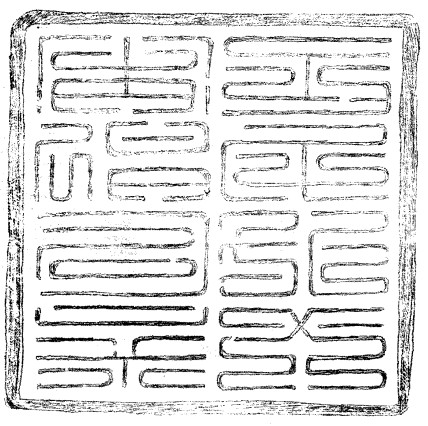
KSRG 1978 plate 49.
References : KSRG 1978 plate 49.
Found at : Unknown (impression of seal owned by Luo Fuyi 羅福頤).
Description : Bronze seal.
Inscription : Eight Khitan large characters in ninefold seal script calligraphy (24 folds), in two columns (four characters in each column).
Interpretation
The 4th character looks like *ka, but I think it is probably *tʃu, used to transliterate Chinese chǔ 處 "place".
The 5th character *tai is used to transliterate Chinese dà 大 "great".
Seal A11
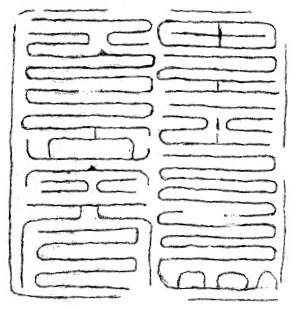
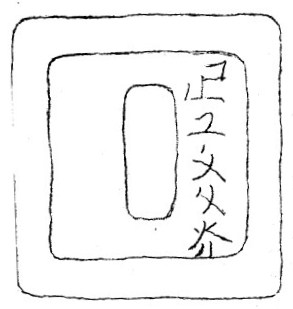
KSRG 1978 plate 40.
References : KSRG 1978 plate 40.
Found at : Weichang Manchu and Mongol Autonomous County, Hebei (河北圍場縣).
Present Location : Inner Mongolia Museum (內蒙古自治區博物館).
Description : Bronze seal.
Inscription :
Interpretation
TO BE DONE
Seal A12
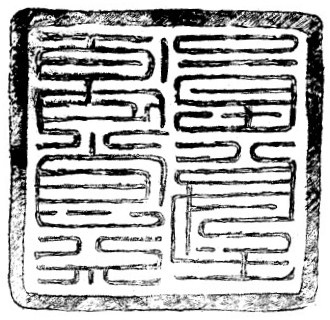
KSRG 1978 plate 41.
References : KSRG 1978 plate 41.
Found at :
Present Location : Tianjin Art Gallery and Museum (天津藝術博物館).
Description : Bronze seal.
Inscription :
Interpretation
TO BE DONE
Seal A13

KSRG 1978 plate 43.
References : KSRG 1978 plate 43.
Found at Xayar County, Xinjiang (新疆自治區沙雅縣).
Present Location : National Museum of China, Beijing.
Description : Bronze seal.
Inscription :
Interpretation
TO BE DONE
Seal A14
Top of the seal
Seal face (mirrored)
References : V.A. Belyaev, A.A. Mospanov, S.V. Sidorovich, "Recently discovered Khitan script official seal of the Western Liao State"; Numismatique Asiatique No. 33 (March 2020): 25–32.
Found at Ustyurt Plateau in Uzbekistan.
Present Location : Private ownership.
Description : Bronze seal with a handle. The handle is engraved with the Chinese character shàng 上 "up". There is an inscription in 20 Khitan Large Script characters running clockwise around the edges of the upper surface.
Inscription : Nine Khitan large characters in ninefold seal script calligraphy (15–17 folds), in two columns (five characters in the first column, four characters in the second column).
Interpretation
The inscription on the back of the seal comprises two parts: the first ten characters (1–10) give the date of issue; and the final ten characters (11–20) give the text of the seal face inscription (but with the penultimate genitive particle omitted on the seal face). Belyaev et al. read the inscription as follows:
- : "heaven"
-
-
- : "twenty"
- : "year"
- : "three"
- : "month"
- : dative particle
-
-
-
- : "dragon" or transcription for Chinese lù 禄 "official salary"
- : transcription for Chinese yún 雲 or yǐn 尹
- : "ox"
-
- : "left"
-
-
- : genitive particle (omitted in the seal face inscription)
- : "seal"
My reading of the inscription, which is slightly different from above, is shown below.
 |
 |
 |
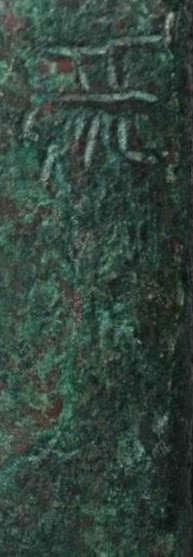 |
|
The 1st character "heaven" occurs as the first element of many Khitan era names (even where the corresponding Chinese era name does not include the character 天 tiān "heaven"), and so this is almost certainly the start of the name of the era during which the seal was made. However, the following two characters do not match any known Khitan Large Script era name. In fact, it is difficult to identify what the characters are, or even what the segmentation of the characters is. It is not even certain whether there are two or three characters between "heaven" and the following "twentieth year".
The 4th and 5th characters "twentieth year" indicate the year of the preceding era. The 6th and 7th characters "third month" indicate the month of the preceding year. The 8th character is a dative particle, so the first eight characters translate as "in the 3rd month of the 20th year of the Heavenly XXX era".
The 9th character occurs rarely in Khitan epitaphs, and is of unknown meaning. However, it also also occurs in the inscription on the back of Seal A9, also immediately after the dative particle at the end of the date. It could therefore plausibly be a verb such as "to make", "to engrave", or "to bestow on".
The 10th character also occurs in the inscription on the back of Seal A9, also as the last character before the copy of the seal face inscription. It looks like "three" and "month" combined together, but perhaps is intended as (meaning unknown) which is attested on one of the fragments of a Khitan Large Script memorial stone found at the site of the Liao Upper Capital:
The 11th character (1st character of the seal face inscription) occurs in the Epitaph for Yelü Qi on lines 23–24 in the phrase , where it is preceded by the word "Northern Administration" and followed by the character meaning 'bureau' (Chinese yuàn 院). This character is perhaps related to the first character of the seal face inscription of Seal A9 as the righthand part of the seal script form of that character is identical to .
I do not think that the 12th character (2nd character of the seal face inscription) is (also written ) "dragon", but that it is actually (also written ) "nine".
I am not convinced that the 13th character (3rd character of the seal face inscription) is as it looks to me like "又" at the bottom, although at present I do not have a better suggestion.
The 14th and 15th characters (4th and 5th characters of the seal face inscription) form a word of unknown meaning which occurs three times in the Epitaph for Yelü Qi:
- ( = Khitan Small Script 𘰷𘯡𘳕 s.êŋ.un = xiángwěn 詳穩 "general or tribal leader") [lines 16 and 32]
- ( = Chinese guó zhī 國之 "of the state"; = Chinese chén 臣 "minister"; = Chinese shǐ 使 "envoy", shì 侍 "attendant", or shī 師 "teacher") [lines 16–17]
The 16th, 17th, and 18th characters (6th, 7th, and 8th characters of the seal face inscription) also occur on the seal face inscription of Seal A9: ( = ). The character "left" refers to the division of many offices and military positions into "left" and right" roles, and presumably modifies the position represented by the two characters . If is derived from and represents the pronunciation of Chinese 尚 shàng, then the term might represent the Chinese office of zuǒ shàngshǔ 左尚署 "Left Service Office" (Hucker #6988).
The 19th and 20th characters form the standard formula "seal of", although the seal face inscription omits the genitive particle .
Era Name The inscription on the back of the seal starts with an unknown era name ( is a variant of , but is otherwise unattested) followed by "20th year". There are only two Liao dynasty eras which are twenty years or longer in duration: Tǒnghé 統和 = or (983–1012); and Chóngxī 重熙 = (1032–1055). The era name on the seal does not match the Khitan Large Script names for either of these two eras, so either it is an alternative name or spelling for one of these eras, or it is not a Liao dynasty era name. There is a single Jin dynasty era, Dàdìng 大定 (1161–1189), which lasted longer than twenty years, but by the second half of the 12th century the Khitan scripts had been replaced by the Jurchen script, and it is very unlikely that the Khitan Large Script would have been used on official seals at this date. Indeed, all Jin dynasty official seals that I know of use the Chinese script exclusively, so I think this possiblility can be discounted. The only other dynasties to use the Khitan script were the short-lived Northern Liao (1122–1123) and the Western Liao or Qara Khitai (1124–1218). The Western Liao ruled over a large area of Central Asia, including the region of Uzbekistan where the seal was found, and the last emperor, Yelü Zhilugu used the era name Tiānxǐ 天禧 from 1178 to 1211/1218. Belyaev et al. therefore conclude that the era name on the seal is the Khitan form of the Tiānxǐ era, and that the 20th year of the era, when the seal was engraved, refers to Tiānxǐ 20, i.e. 1197. I agree with them that this is the most plausible explanation.
Seal A9 As noted above, there are several striking similarities between the back inscription on this seal and the back inscription on Seal A9, which was found in the Ili Kazakh Autonomous Prefecture of Xinjiang, within the borders of the Western Liao state. Not only are A9 and A14 the only two seals I know of with an inscription on the back that reads clockwise around the four sides, but they share the characters and (elsewhere both very rare characters), and significantly finish with the same five characters . I do not think that these textual similarities can be coincidence, but they must indicate that both seals were created at the same period of time in the same geopolitical environment. I conclude that if A14 was created under the Western Liao, then A9 must also have been issued by the Western Liao. The inscription on the back of A9 starts followed by "2nd year", so the first six characters should an era name. The first two characters correspond to the Khitan word "good fortune" (Chinese fú 福), so it is possible that the six characters together are the Khitan form of the Chóngfú 崇福 ("Venerating good fortune") era (1164–1178) used by the Empress Dowager Chengtian 承天太后 between the reigns of the 2nd and 3rd emperors. If this is the case, the 2nd year on the seal would refer to Chóngfú 2, i.e. 1165.
B. Other Seals
The seals below are a mixed bunch whose defining feature is just that they are not typical ninefold seal script official seals, although most of them still have the appearance of being official seals. The inscriptions on these seals are not easy to read, and it is not certain that they are all written in the Khitan large or small script.
Seal B1
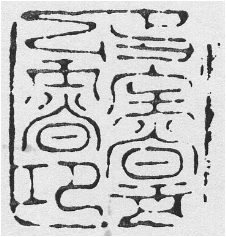
Wen Wu 文物 1983.08 p.82.
Found at : Balin Youqi, Inner Mongolia (内蒙古自治區巴林右旗) in 1973.
Present Location : Chifeng Museum (赤峰市博物館).
The seal inscription appears to consist of eight characters in two columns (four characters in each column). The characters are written in seal script calligraphy, but not the convoluted ninefold seal script form. The inscription can be identified as being in the Khitan large script as the 3rd and 7th characters are the Khitan large script genitive particle *-un. However, the other characters are not easily identifiable, and the last character (following the second genitive particle) is not the standard Khitan large character for "seal", so the inscription does not read "Seal of ...".
Seal B2
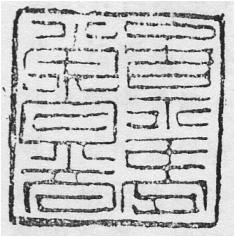
Wen Wu 文物 1983.09 p.70.
Found at : Jianchang, Liaoning (遼寧省建昌縣) in 1980.
The seal inscription appears to consist of six characters in two columns (three characters in each column). The characters are written in a rather loose ninefold seal script calligraphy, not typical of the formal ninefold seal script calligraphy of the A seals. Moreover, none of the characters are the same as those used in the A seals.
Seal B3

Liaoling Shike Jilu 遼陵石刻集錄 vol.5.
The seal inscription appears to consist of six characters in two columns (three characters in each column). The characters are written in a seal script calligraphy, although not the ninefold seal script calligraphy of the A seals.
Seal B4
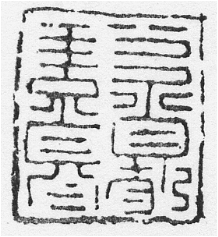
Wen Wu 文物 1984.09 p.83.
Found at : Gaixian, Liaoning (遼寧省蓋縣) in 1972.
Present Location : Liaoning Provincial Museum, Shenyang
The inscription on this seal is in a seal script calligraphy. It has been identified as a Khitan small script seal, but I am not convinced of this.
Seal B5
Photos by BabelStone, 27 August 2016, CC BY-SA 3.0
Found at : Site of the Liao Upper Capital (上京) at Bairin Left Banner, Inner Mongolia (内蒙古自治區巴林左旗) in 1975.
Present Location : Liao Upper Capital Museum (遼上京博物館), Lindong, Bairin Left Banner, Inner Mongolia.
Inscription :
This is a pottery seal, which is very unusual as official seals are normally made of bronze. The inscription on the seal is in ninefold seal script calligraphy, but it is very hard to identify any characters or even determine how many characters there are meant to be. It does not look at all like any other Khitan large script seal inscription I have seen, and if it were not for its provenience I would doubt that it was a Khitan seal at all.
Seal B6
Mirror image of the seal face
Artxun: 契丹 铜制官印
There are a huge number and variety of fake Khitan-inscribed coins and artefacts for sale on the internet and through Chinese auction houses, so I am naturally reluctant to include in this post random seals that I have found on the internet. However Seals B6 and B7 are very different from the typical fake Khitan objects that can be found on the internet, and I think it is possible that they are genuine. They are very similar in appearance, and if they are genuine I suspect they must have been found together (as is normal with Chinese auctions, no provenance is provided, and we are left to guess that they are either modern forgeries or were robbed from a tomb).
The seal inscription comprises six Khitan large script characters in two columns (three characters per column), in a rather uncouth seal script calligraphy. The third character is (also written ) "big". The fifth and sixth characters are *-un doro "seal of ...".
Seal B7
Mirror image of the seal face
Artxun: 契丹 铜制官印
The seal inscription comprises six Khitan large script characters in two columns (three characters per column), in a similar seal script calligraphy as Seal B6. The third character is *fu, the fourth character is "big". The last character could be a badly written form of the character *doro "seal", although it is not preceded by a genitive particle as is normally the case.
Table of Khitan Ninefold Seal Script Characters
| Seal Character Glyphs | Standard Form | Meaning | ||||
|---|---|---|---|---|---|---|
 |
 |
 |
 |
 |
| "Seal" *doro (Chinese 印). This character has also been normalized as in some academic studies, but that character form does not occur in epitaphs. |
 |
 |
| ||||
 |
 |
 |
 |
 |
| Genitive particle *-un for stems with a u vowel or ending in w (Chinese 之). |
 |
 |
 |
 |
| Used to transcribe Chinese characters pronounced fu, including 府, 夫, 父, 副, 傅. | |
 |
 |
| Possibly used to transcribe the Chinese character 都 dū. | |||
 |
| First character of the Khitan office corresponding to Shumiyuan 樞密院 (Bureau of Military Affairs) | ||||
 |
| Second character of the Khitan office corresponding to Shumiyuan 樞密院 (Bureau of Military Affairs) | ||||
 |
| "Division" or "group" (Chinese 院) in the word 六院 *uru "six divisions" or "six groups"; or phonetic transcription for u. | ||||
 |
| 院 'bureau' | ||||
 |
 |
 |
| 都 | ||
 |
| Second element in a collocation that may be an unknown Khitan word for Liao or an epithet specifically refering to the Khitan state. | ||||
 |
 |
|||||
 |
||||||
 |
||||||
 |
||||||
 |
||||||
 |
||||||
 |
 |
| Transliterates Chinese 同 tóng and 統 tǒng. | |||
 |
||||||
 |
| *ŋ (initial phoneme in *ŋĭwan = Chinese yuán 元 | ||||
 |
 |
| *üe (medial phoneme in *ŋĭwan = Chinese yuán 元 | |||
 |
 |
| *an (final phoneme in *ŋĭwan = Chinese yuán 元 | |||
 |
| *ʃ (initial phoneme in *ʃoi = Chinese shuài 帥 | ||||
 |
| *oi (final phoneme in *ʃoi = Chinese shuài 帥 | ||||
 |
左 ? | |||||
 |
 |
| 都 | |||
 |
 |
| 監 | |||
 |
督 ? | |||||
 |
| |||||
 |
| |||||
 |
| *xua | ||||
 |
| |||||
 |
| = *so or zo "left" (左) ? | ||||
 |
| *go | ||||
 |
| |||||
 |
帥 ? | |||||
 |
||||||
 |
||||||
 |
||||||
 |
||||||
 |
| 處 | ||||
 |
| 大 | ||||
 |
||||||
 |
||||||
Bibliography
- Khitan Script Research Group [KSRG] (契丹文字研究小组), Qidan Dazi Ziliao Huiji 契丹大字资料汇辑 [Compendium of Materials Relating to the Khitan Large Script]. 1978.
- Feng Yongqian 冯永谦 and Deng Baoxue 邓宝学, "Liaoning Jianchang pucha zhong faxian de zhongyao wenwu" 辽宁建昌普查中发现的重要文物 [Important cultural relics discovered during a survey of Jianchang in Liaoning]; Wenwu 文物 [Cultural Relics] 1983.9: 66–72.
- Iguro Shinobu 井黒忍, "Hokutō Ajia shutsudo kan'in shūsei hyō (kō)" 北東アジア出土官印集成表(稿) [Table of official seals found in northeast Asia (draft)]; Hokutō Ajia Chūsei Iseki no Kōko Gakuteki Kenkyū 北東アジア中世遺跡の考古学的研究 [Archaeological Studies of Medieval sites in North-East Asia] (2005): 80–96.
- Imanishi Shunjū 今西春秋, "Joshin ji dō'in" 女真字銅印 [A bronze seal with Jurchen characters]; Tōyōshi Kenkyū 東洋史研究 [Journal of Oriental Researches] vol.3 no.4 (April 1938).
- Li Yiyou 李逸友, "Neimenggu chutu gudai guanyin de xin ziliao" 内蒙古出土古代官印的新资料 [New materials on ancient official seals unearthed in Inner Mongolia]; Wenwu 文物 [Cultural Relics] 1961.9: 64–65.
- Li Yufeng 李宇峰, "Liaoning Panshan Xian faxian Liao Qidan dazi tongyin" 辽宁盘山县发现辽契丹大字铜印 [A bronze seal with Khitan large characters discovered in Panshan County in Liaoning]; Kaogu 考古 [Archaeology] 1990.12: 1143.
- Liu Fengzhu 刘凤翥, "Qidan dazi 'Dutongfu zhi yin' de jiedu" 契丹大字“都统府之印”的解读 [Decipherment of the Khitan large script 'Dutongfu zhiyin' seal]; Beifang Wenwu 北方文物 [Northern Cultural Relics] 2012.3: 62.
- Liu Fengzhu 劉鳳翥, "Yimei Qidan dazi yinzhang de jiedu" 一枚契丹大字印章的解讀 [Decipherment of a Khitan large script seal]; Wenshi 文史 [Cultural History] 2003.1: 177–178.
- Pei Yaojun 裴耀军, "Changtu Bamiancheng chutu yimei Qidanwen tongyin" 昌图八面城出土一枚契丹文铜印 [A bronze seal with khitan inscription unearthed from Bamiancheng in Changtu]; Liaohai Wenwu Xuekan 遼海文物學刊 [Liaohai Cultural Relics Journal] 1989.2: 98.
- Wu Jiachang 武家昌, "Liaoning jinnian chutu, zhengji de Song-Liao-Jin guanyin xuanji" 辽宁近年出土、征集的宋辽金官印选辑 [Selected Song Liao and Jin official seals unearthed or collected from Liaoning in recent years]; Wenwu 文物 [Cultural Relics] 1984.9: 83–84.
- Xiang Chunsong 项春松, "Neimenggu Zhaowudameng faxian de yipi guyin ziliao" 内蒙古昭乌达盟发现的一批古印资料 [Material on some ancient seals discovered in Juuda League, Inner Mongolia]; Wenwu 文物 [Cultural Relics] 1983.8: 77–83.
- Wang Lianchun 王连春 and Xu Yulin 许玉林, "Dandong diqu chutu de yipi gudai guanyin" 丹东地区出土的一批古代官印 [Some ancient official seals unearthed from the area of Dongdan]; Heilongjiang Wenwu Congkan 黑龙江文物丛刊 [Cultural Relics of Heilongjiang] 1983.2: 56–60. [not seen]
- Yin Yushan 尹郁山, "Jilin Yongji faxian Qidanwen tongyin" 吉林永吉发现契丹文铜印 [A bronze seal with Khitan inscription found in Yongji, Jilin]; Beifang Wenwu 北方文物 [Northern Cultural Relics] 1986.2: 49.
Initial version: 2012-10-16 (14 seals)
Revised and expanded: 2019-09-17 (24 seals)
Last revised: 2023-06-08
Index of BabelStone Blog Posts




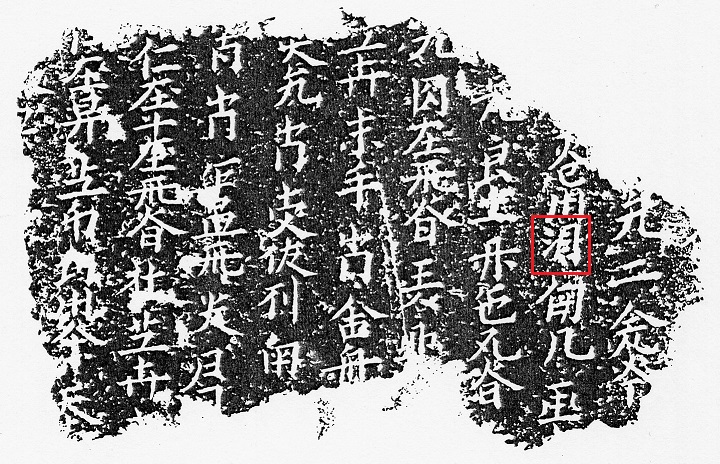
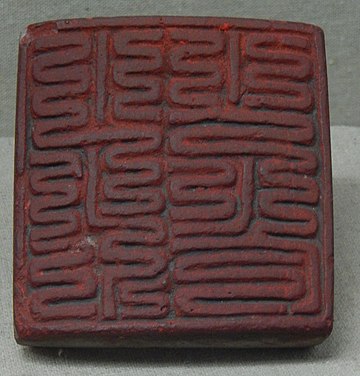
.jpg)
